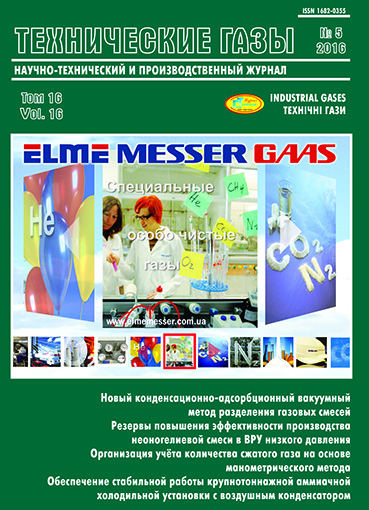SECURING OF A STEADY OPERATION OF A LARGE-SCALE AMMONIA REFRIGERATION PLANT WITH AN AIR-COOLED CONDENSER
DOI:
https://doi.org/10.18198/j.ind.gases.2016.0840Keywords:
Ammonia, Ammonia refrigeration plant, Ammonia condensation, Air-cooled condenser, Receiver, Collector circuit, Hydraulic resistance, Non-condensing gases, Concentration, Algorithm, Fan, Valve, Work stabilization, Ammonia lossesAbstract
The efficiency of a large-capacity ammonia refrigeration plant (ARP) with an air condenser depends on many factors. Changes in some of them in the condenser with a collector circuit lead to additional hydraulic resistances within the system. They are caused by ambient temperature changes, the accumulation of non-condensable gases in the system, the design features of the condenser and the uneven distribution of ammonia in the condenser coils. All this causes a pressure increase in the condenser and, consequently, excess demand energy, which is explained by the presence of non-condensable gases (NCG) in the system. The latter, in its turn, leads to the unnecessary more frequent opening of NCG relief valves, which results in a significant loss of ammonia. The reasons for the emergence of additional hydraulic resistances on the example of large-capacity ARP have been researched. The basic reasons for changing the operating parameters of the refrigeration unit, indicating the presence of NCG or the occurrence of resistance in the hydraulic system, worsening the drain of liquid ammonia from the condenser to the receiver have been determined. In order to stabilize the operation of ARP with an air cooled condenser and to reduce the resulting hydraulic resistance, as well as ammonia losses, we have developed and explained new algorithms of gas flaring and operating modes of air cooling fans that reduce the loss of ammonia by 10 times and the hydraulic resistance in the air condenser by 30 kPa.
Downloads
Issue
Section
License
LICENSE AGREEMENT
After receiving an article for publication as required revision scientometric databases each author directs the license agreement on the assignment and transfer of the management of copyright. Signatures of the author (s) it is desirable to seal the personnel department of the institution where the author works (authors), or the seal of the Faculty.
Revision refers to the authors one layout for proofreading. Permissible only those fixes that result in compliance with the layout of the original text of the article. Significant changes are not permitted. Layout should be sent to the editorial office within days of receipt.

